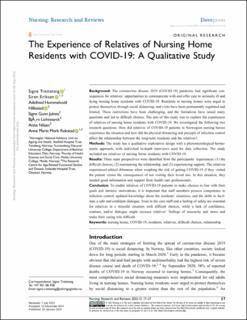| dc.contributor.author | Tretteteig, Signe | |
| dc.contributor.author | Eriksen, Siren | |
| dc.contributor.author | Hillestad, Adelheid H. | |
| dc.contributor.author | Julnes, Signe Gunn | |
| dc.contributor.author | Lichtwarck, Bjørn | |
| dc.contributor.author | Nilsen, Anita | |
| dc.contributor.author | Rokstad, Anne Marie Mork | |
| dc.date.accessioned | 2023-08-21T10:50:15Z | |
| dc.date.available | 2023-08-21T10:50:15Z | |
| dc.date.created | 2022-01-24T14:02:40Z | |
| dc.date.issued | 2022 | |
| dc.identifier.citation | Nursing: Research and Reviews. 2022, 12 17-27. | en_US |
| dc.identifier.uri | https://hdl.handle.net/11250/3085023 | |
| dc.description.abstract | Background: The coronavirus disease 2019 (COVID-19) pandemic had significant consequences for relatives’ opportunities to communicate with and offer care to seriously ill and dying nursing home residents with COVID-19. Residents in nursing homes were urged to protect themselves through social distancing, and visits have been permanently regulated and limited. These restrictions have been challenging, and the limitations have raised many questions and led to difficult choices. The aim of this study was to explore the experiences of relatives of nursing home residents with COVID-19. We investigated the following two research questions: How did relatives of COVID-19 patients in Norwegian nursing homes experience the situation and how did the physical distancing and precepts of infection control affect the relationship between the long-term residents and the relatives?. Methods: The study has a qualitative explorative design with a phenomenological-hermeneutic approach, with individual in-depth interviews used for data collection. The study included ten relatives of nursing home residents with COVID-19. Results: Three main perspectives were identified from the participants’ experiences: (1) the difficult choices; (2) maintaining the relationship; and (3) experiencing support. The relatives experienced ethical dilemmas when weighing the risk of getting COVID-19 if they visited the patient versus the consequences of not visiting their loved one. In this situation, they needed good information and support from health care professionals. Conclusion: To enable relatives of COVID-19 patients to make choices in line with their goals and intrinsic motivations, it is important that staff members possess competence in infection control, updated knowledge about the residents’ situations, and the skills to facilitate a safe and confident dialogue. Trust in the care staff and a feeling of safety are essential for relatives in a stressful situation with difficult choices, while a lack of confidence, routines, and/or dialogue might increase relatives’ feelings of insecurity and stress and make their caring role difficult. | en_US |
| dc.description.abstract | The experience of relatives of nursing home residents with COVID-19 : a qualitative study | en_US |
| dc.description.sponsorship | The study was funded by the Norwegian National Advisory Unit on Ageing and Health, Vestfold Hospital Trust; Lovisenberg Diaconal University College; the Faculty of Health Sciences and Social Care, Molde University College; and the Research Centre for Age-related Functional Decline and Disease, Innlandet Hospital Trust. | en_US |
| dc.language.iso | eng | en_US |
| dc.publisher | Dove Medical Press | en_US |
| dc.relation.uri | https://doi.org/10.2147/NRR.S328336 | |
| dc.rights | Navngivelse-Ikkekommersiell-DelPåSammeVilkår 4.0 Internasjonal | * |
| dc.rights.uri | http://creativecommons.org/licenses/by-nc-sa/4.0/deed.no | * |
| dc.subject | nursing home; | en_US |
| dc.subject | COVID-19; | en_US |
| dc.subject | residents; | en_US |
| dc.subject | relatives; | en_US |
| dc.subject | difficult choices; | en_US |
| dc.subject | relationship; | en_US |
| dc.title | The experience of relatives of nursing home residents with COVID-19 : a qualitative study | en_US |
| dc.title.alternative | The experience of relatives of nursing home residents with COVID-19 : a qualitative study | en_US |
| dc.type | Peer reviewed | en_US |
| dc.type | Journal article | en_US |
| dc.description.version | publishedVersion | en_US |
| dc.rights.holder | © 2022 Tretteteig et al. This work is published and licensed by Dove Medical Press Limited. The full terms of this license are available at https://www.dovepress.com/terms.php and incorporate the Creative Commons Attribution – Non Commercial (unported, v3.0) License (http://creativecommons.org/licenses/by-nc/3.0/). By accessing the work you hereby accept the Terms. Non-commercial uses of the work are permitted without any further permission from Dove Medical Press Limited, provided the work is properly attributed. For permission for commercial use of this work, please see paragraphs 4.2 and 5 of our Terms (https://www.dovepress.com/terms.php). | en_US |
| dc.source.pagenumber | 17-27 | en_US |
| dc.source.volume | 12 | en_US |
| dc.source.journal | Nursing: Research and Reviews | en_US |
| dc.identifier.doi | 10.2147/NRR.S328336 | |
| dc.identifier.cristin | 1988641 | |
| cristin.ispublished | true | |
| cristin.fulltext | original | |
| cristin.qualitycode | 1 | |

